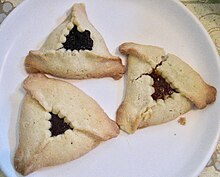Hamentash

Three hamantashen. At top: Poppy seed. Bottom left: Raspberry. Right: Apricot.
|
|
| Type | Cookie or pastry |
|---|---|
| Place of origin | Ashkenazi Jewish communities |
| Variations | Filling: traditionally poppy seed |
A hamantash (Yiddish: המן טאַש, also spelled hamentasch, pl. המן טאַשען hamantashen or hamentaschen, literally 'Haman pockets') (Hebrew: אוזן המן, ozen Haman, pl. אוזני המן, oznei Haman, literally 'Haman's ears') is a filled-pocket cookie or pastry recognizable for its triangular shape, usually associated with the Jewish holiday of Purim and Haman, the villain in the Purim story. The shape is achieved by folding in the sides of a circular piece of dough, with a filling placed in the center. Hamantashen are made with many different fillings, including poppy seed (the oldest and most traditional variety), prunes, nut, date, apricot, raspberry, raisins, apple, fruit preserves in a lekvar style, cherry, fig, chocolate, dulce de leche, halva, or even caramel or cheese. Their formation varies from hard pastry to soft doughy casings.
Hamantash is also spelled hamentasch, homentash, homentasch, or even (h)umentash. The name hamantash is commonly viewed as a reference to Haman, the villain of Purim, as described in the Book of Esther. The pastries are supposed to symbolize the defeated enemy of the Jewish people. The word tasche means "pouch" or "pocket" in German, and thus may refer to Haman's pockets, symbolizing the money that Haman offered to Ahasuerus in exchange for permission to destroy the Jews. Naked Archaeologist documentarian Simcha Jacobovici has shown the resemblance of hamantaschen to dice from the ancient Babylonian Royal Game of Ur, thus suggesting that the pastries are meant to symbolize the pyramidal shape of the dice cast by Haman in determining the day of destruction for the Jews. Another possible source of the name is a folk etymology: the original Yiddish word מאָן־טאַשן (montashn) or the German word Mohntaschen, both meaning poppyseed-filled pouches, was transformed to hamantaschen, likely by association with Haman. This use of "-tasche" in reference to filled pouches of dough is common in modern German, e.g., in "Teigtasche", "Apfeltasche", "Maultasche". In Israel, hamantaschen are called oznei Haman (Hebrew: אוזני המן), Hebrew for "Haman's ears" in reference to their defeated enemy's ears.
...
Wikipedia
